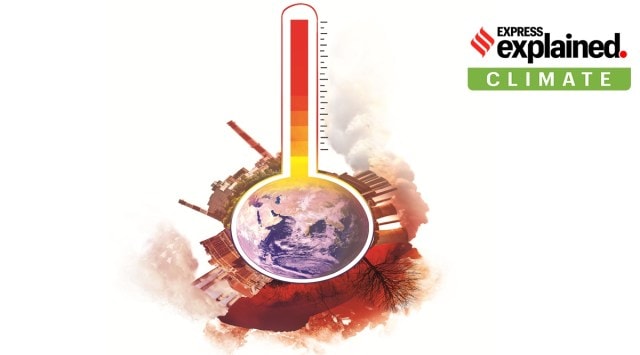- India
- International
New In The New Year: 1.5 degree warmer world looms, but it’s not the end
The global failure to reduce greenhouse gas emissions in time evokes dire scenarios. But attention focused on this failure often overshadows the progress being made in adapting to the new world
 Climate disasters across the world increased almost five-fold from the 1970-79 decade to the 2010-2019 period.However, the number of human lives lost declined by almost 70 per cent. (Illustration: Suvajit Dey)
Climate disasters across the world increased almost five-fold from the 1970-79 decade to the 2010-2019 period.However, the number of human lives lost declined by almost 70 per cent. (Illustration: Suvajit Dey) This year’s climate change conference in Egypt, COP27, was hailed as ‘historic’ for its decision to create a fund to help developing countries recover from climate-induced disasters. While the decision undoubtedly addressed a long-pending demand of the developing countries, there was little else in the final outcome of the Sharm el-Sheikh meeting that can be seen as a half-adequate response to, what according to science is, an extremely urgent global climate emergency.
But this is not the first time that the annual climate conference has underperformed. COPs, especially the ones in the past 15 years, have been major underachievers. While they have managed to bring climate change to the forefront of the global agenda, the response, in terms of effective climate action, has never been commensurate with the scale of the problem. In fact, the way the Paris Agreement is designed — with every country being asked to come up with what it thinks is its best effort — it can only lead to a suboptimal outcome.
The 1.5 degree Celsius warmer world
The result has been that the world is now almost certain to miss the 1.5 degree Celsius target. The Sharm el-Sheikh outcome acknowledges that global greenhouse gas emissions need to be reduced by at least 43 per cent from 2019 levels by the year 2030, if hopes of keeping the temperature within 1.5 degree Celsius from pre-industrial times are to remain alive. The problem is that this reduction has not even started. In fact, greenhouse gas emissions are still on the rise. Latest estimates suggest that the emissions for 2021, still to be calculated, would be higher than 2019, and a new record.
In the meanwhile, the world has already warmed by more than 1.1 degree Celsius. According to the World Meteorological Organisation (WMO), the year 2022 is likely to end up being about 1.15 degree Celsius warmer than pre-industrial times. It could have been even hotter if not for the cooling effect of the unusually prolonged La Nina event, which has entered its third year now. The warmest year on record, 2016, was about 1.28 degree Celsius hotter than pre-industrial times (see chart).
In a report published in May this year, the WMO said there was a 50 per cent chance of the 1.5 degree Celsius warming mark getting breached in the next five years, even though temporarily. And it was almost certain (93 per cent probability) that one of the next five years would be warmer than 2016.

The reports of the Intergovernmental Panel on Climate Change (IPCC) have also suggested that the question was not whether the 1.5 degree Celsius mark would be breached — it almost certainly will — but whether the world would take adequate action to pull itself back from there after a few years. The 1.5 degree Celsius warmer world would be here probably even before we expect it to.
Not all is lost
Contrary to the catastrophic imagery that it often evokes, the 1.5 degree Celsius warmer world would not be dramatically different from what we have today. There is nothing that would happen then that does not already happen now. Of course, the frequency and intensity of extreme weather events are predicted to increase with further rise in temperature. But, in itself, the 1.5 degree Celsius mark is no special trigger. Neither is the 2 degree Celsius mark. The effort is to restrict the rise in temperatures to as low a level as possible in order to minimise the impacts of climate change.
In fact, new science has been suggesting that even at the current levels of warming, some important climate tipping points might already have been crossed, or are very close to being crossed. This can lead to some uncontrollable, irreversible and self-perpetuating changes in the earth’s climate system, and result in other tipping points being breached.
This would seem like a hopeless situation already, but it is not. At least, not yet. Science on the climate tipping points is still evolving, and human ingenuity and resilience often do not get measured in scientific literature.
The despairing scenarios are the result of the failure to reduce greenhouse gas emissions in time. The attention on this failure often overshadows the progress being made in adapting to the new world. Even as climate change-induced disasters have increased rapidly in the past decade, the number of human lives lost in these incidents has come down sharply – thanks to early warning systems and quick response and relief measures.
Fewer people dying in climate disasters
According to the WMO Atlas of Mortality and Economic Losses from Weather, Climate and Water Extremes, whose latest edition was published last year, climate or weather-related disasters across the globe increased from 711 incidents in the 1970-79 decade to 3,165 incidents in the 2010-2019 period, an almost five-fold increase. However, the number of human lives lost declined by almost 70 per cent, from about 556,000 in the 1970s to just about 185,000 in the previous decade.
Economic losses, however, increased manifold — from about 175 billion USD in the 1970s to nearly 1.4 trillion USD in the 2010s — mainly because of the increase in the frequency of disasters and also in the value of the assets and infrastructure.
This trend is visible in India as well. Deaths from heat waves and cyclones, for example, have reduced by about 90 per cent in the past decade because of effective early warning systems and timely response. Forecasts of cloudburst events, landslides or avalanches may not be reliable, but their impacts can still be minimised by taking remedial measures in high-risk zones.
The problem is that nearly half the world does not have early warning systems or rapid response mechanisms to deal with a disaster. In fact, more than 90 per cent of all deaths in the climate and weather-related disasters between 1970 and 2019 occurred in the developing countries. Even latest estimates show that countries with limited early warning coverage have disaster mortality about eight times higher than better-equipped countries. Low coverage zones also result in data gaps that introduce inefficiencies in global weather models and their capacity to forecast extreme weather events.
Early warning coverage for all
That is why the recent initiative of the WMO to extend the early warning coverage to all the countries in the next five years might be the most significant announcement to have come out of COP27.
The entire programme is likely to cost only about 3.1 billion USD, a relatively small amount of money in climate change context. It is estimated that this investment would save human lives and help avoid losses to the tune of 3 to 16 billion USD every year. Similar work has been initiated by the Coalition for Disaster Resilient Infrastructure (CDRI), an India-backed international organisation, that is focusing on strengthening early warning capabilities in the small island states.
Adaptation efforts like these have hardly received adequate attention from developed countries, which are more focused on getting all the countries to reduce their emissions. The reasons are obvious. Developed countries themselves have a far greater capability to cope with the changes, so most of the adaptation actions would have to happen in the developing world. And unlike in the case of emissions reductions, the benefits of adaptation are local, not global. Developing countries have been demanding that adaptation gets at least half the financial resources flowing into climate action, but less than 20 per cent has been coming in.
This is not to suggest that it is okay to go slow on efforts to reduce greenhouse gas emissions. There are limits to adaptation. But in the short term, this is key to the survival of large population groups in developing countries.
More Explained
EXPRESS OPINION
Apr 26: Latest News
- 01
- 02
- 03
- 04
- 05










































